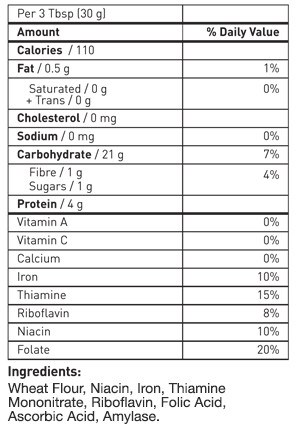Nutritional Information

Enriched/Pre-Sifted Rogers Bread Flour, perfect for all your White Bread making needs, is a pre-sifted blend of enriched, unbleached, white flour and gluten flour.
The increased protein (gluten) content makes it an excellent choice for use in traditional hand-mixed yeast bread recipes and bread machines.
Note: All White Flour must be enriched with 3B Vitamins (Thiamine, Riboflavin and Niacin) and Iron and Folic Acid to bring them up to the levels found in Whole Wheat Flour. This is in accordance with the Flour Enrichment Regulations of the Canadian Food & Drug Act.
Shelf Life: 12 months
Origin: Canada

Safe handling of flour
The Public Health Agency of Canada (PHAC) has issued a reminder on the safe usage and proper handling of flour. Flour comes from grain, which is grown in fields. In the fields, the grain may become contaminated through direct contact with bacteria from:
Flour is a raw ingredient meant to be cooked before it is eaten. Common “kill steps” that are often used during food processing will kill bacteria that may be present in raw flour. Kill steps include:
Health risks
Raw flour may be contaminated with harmful bacteria such as E. coli. People infected with E. coli can have a wide range of symptoms.
Some people do not get sick at all, although they can still spread the infection to others. Others may get an upset stomach or become seriously ill and need to go to the hospital.
Common symptoms of E. coli can appear within 1 to 10 days after contact with the bacteria. Symptoms include:
Most symptoms go away within 5 to 10 days without needing to see a healthcare provider.
Safety tips when handling flour
Follow these tips to avoid illness when handling flour:
Best practices for cooking with flour
When cooking with flour, you should:
Who is at risk
While anyone can become infected with E.coli, certain groups of people are more likely to get sick. These include:
For these people, symptoms may be more severe.